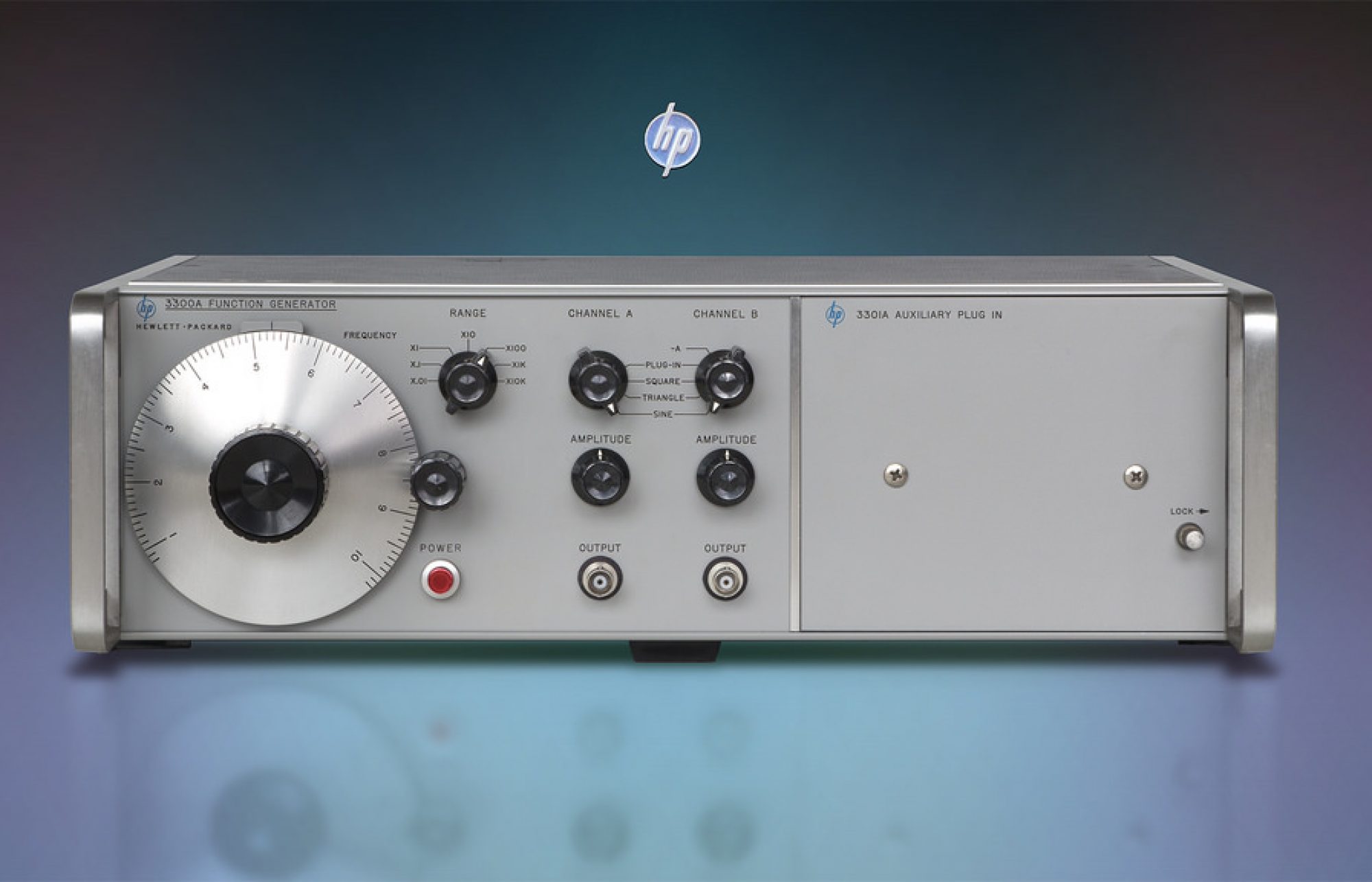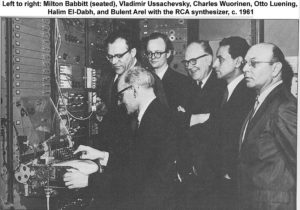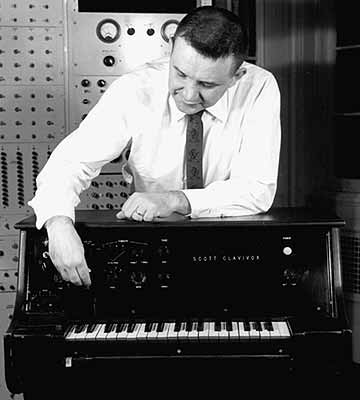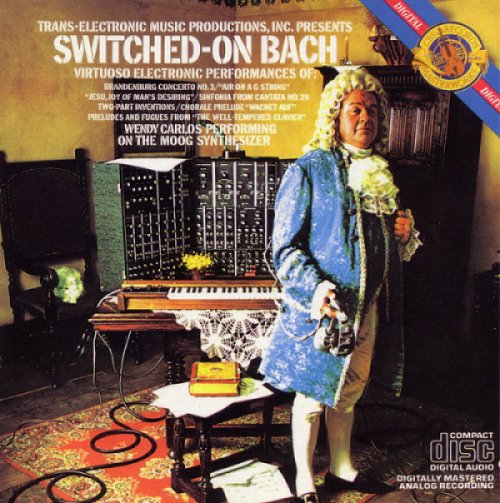Electronic Music Synthesis:
Telharmonium: (also sometime referred to as the “Dynomophone”)
- Thaddeus Cahill, American inventor [1902 v.1-1906 v.2] >>invented electric typewriter, too!
- very large and expensive “one-of-a-kind” instrument cost: over $200,000
- size: ca. 200 tons — moved from Holyoke, MA to NYC in 30 box cars [1906]
- used Edison “dynamos” [electric generators or alternators] spinning at audio-rate cycles/sec. to produce sine wave pitches [NYC unit used 145 dynamos]
- not a true electronic instrument since physical sound waves were actually produced by the spinning dynamos
- used organ-like keyboards to control frequency
- used [limited] additive synthesis control changes in timbre
- ”broadcast” music over NYC telephone lines to subscribers of the service (!?!?!) where it would be heard over large cone speakers (like those on early phonographs)
- not viable financially (perhaps too ambitious for its time). It closed down in 1909 after the novelty wore off.
- Renewed in the project interest in modern times, for its historical significance has resulted in an entire book being written on the instrument.
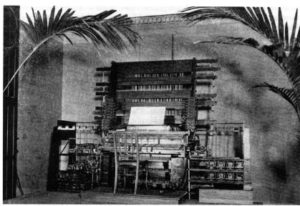

http://magneticmusic.ws/mmvideo.htm
Scroll down and play the flash video. It’s an excellent, well-researched little documentary.
Triode Vacuum Tube:
- Lee DeForest American inventor [1906]
- made amplification of electronic signals possible
- led to experiments with electronic oscillators and true electronic instruments
Theremin:
- Leon Termen, Russian inventor [1919]
- did not imitate any acoustic instrument, no “musically influenced” interface
- 2 “poles” used: 1 controls frequency, the other controls amplitude [determined by proximity: closer = higher/softer — further away = lower/louder
- produced 2 ultra-sonic sine waves oscillators — 1 fixed & 1 variable — difference tone is audible.
- great for wild vibrato, portamento, swooping glissando, difficult to play and articulate even simple melodies.
- oldest electronic instrument design still in use today [Bob Moog’s company continues to market them.]
Notable Uses: >old horror and sci-fi films [e.g. Hitchcock’s Spellbound and The Day the Earth Stood Still featuring performances by Samuel Hoffman.
>Led Zepplin’s concert tour movie; The Song Remains The Same
Paul Tanner & the Electro-Theremin: used by the Beach Boys (Good Vibrations, Wild Honey, etc.)
- trombonist with Glenn Miller; ABC staff orchestra; Hollywood studios. (career spans 60 years!)
- wrote one of the most used jazz method books and taught at UCLA.
- developer and performer of the Electro-Theremin — heard in several songs by the Beach Boys (I Just Wasn’t Made for These Times, Good Vibrations, and Wild Honey)
- TV & Film work: The D.A.’s Man [1959], Ford’s Startime Theater, My Favorite Martian, I Love Lucy (occasional episodes), Strait-Jacket [1964 — starring Joan Crawford ]After seeing a struggling thereminist trying to get his instrument to work, Tanner said to himself, “There has to be a better way!” Which lead to the invention of the Electro-Theremin….
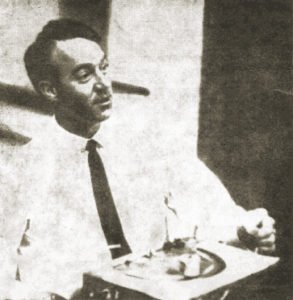
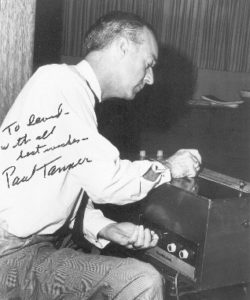
An Electro-Theremin is the creation of actor/electronics wizard, Bob Whitsell (photo above). It is a mechanical controller of an audio oscillator. Whitsell invented the first one in 1958 and it was with this instrument that Paul Tanner recorded Music from Heavenly Bodies. Several weeks later, Whitsell began designing an improved version, one that was played in a straight, linear movement of the hand (as opposed to the first version’s arc-like movement). It was with this instrument that Tanner recorded the numerous TV and movie soundtracks as well as the LP, Music from Outer Space and the three Beach Boys’ tunes.
The Electro-Theremin is simple mechanical controller for an oscillator. A hand device controls pitch by moving back and forth along a keyboard diagram, and on that hand device a switch that controls articulation. The left hand riding the knob of an amp controls volume..
Trautonium:
- Friedrich Trautweine, Russian inventor [1928]
- monophonic keyboard interface; subtractive synthesis; used mostly in research
- some composers wrote for it — Paul Hindemith (German >> American)
Ondes Martenot:
- Maurice Martenot, French inventor [1928]
- monophonic keyboard interface plus “ribbon” controller; additive synthesis
- timbre and envelope were controllable, as was volume [by means of a special key or knee lever]
- quite popular from the late-1920’s through the 1950s [especially in France] 100’s of compositions!
- many composers: notably Oliver Messiaen and Darius Milhaud.
This is a wonderful and detailed interview/demo of this old (and now very rare) instrument.
Darius Milhaud: Suite for Ondes Martenot
Hammond Organ:
Laurens Hammond, American inventor [1929]
develops the concepts of the Telharmonium, by with significant progress made in the miniaturization process, thus it is not a true electronic instrument since it to produces physical sound waves electromagnetically which are then amplified.
12 alternators used to produce sine wave harmonics [1,2,3,4,6,8,10,12]
******NOTE: all these inventions are primarily “live performance” instruments*******
The Classical Electronic Music Studio
Review: Pierre Schaeffer …[1948] at Paris radio station RTF (Radiodiffusion-television Français) marks just the beginning of collaboration between classical composers and state-run radio stations throughout the rest of the world. He continued to be mostly involved in musique concrète.
Typical equipment for early studios:
- several sine wave generators; calibrated (maybe other waveform generators, too)
- noise generators • filters • ring modulators • amplitude & envelope control
- maybe an early electronic keyboard
- several tape recorders, from full-track mono up to (eventually) 4-track; with variable speed tape loop players and editing equipment
Show–and–Tell:
>>> also Additive Synthesis Demos (Max/MSP)
Other Radio Stations-based Studios:
Cologne, Germany: [1951] NWDR (Nordwest Deutsche Rundfunk)
> primary composer: Karlheinz Stockhausen (two works on listening list for Exam 2)
Listening Example: Study II, by Karlheinz Stockhausen (1954)
- discussion of work and process: additive synthesis (non-harmonic); much tape editing!!!
- In the early 1950s, Stockhausen led a heated war of esthetics over what was the “real” electronic music.
- The early opinion of Stockhausen and his followers was that only music in which the original sounds were generated electronically constituted the “real” electronic music, therefore musique concrète was invalid, in his opinion. By mid-1950’s (with Stockhausen’s Gesang der Junglinge, 1956) the issue had dissolved.
- Another major difference was the importance of abstract “rational” or mathematical organization of sound among Stockhausen and his followers versus the more intuitive approach for musique concrète.
Studios modeled on Cologne: mid-1950’s
- Tokyo, Japan: [1955] NHK (Radio Nippon Horo Kyokai)
> primary composers: Toshiro Mayuzumi and Toru Takemitsu (Water Music) - Milan, Italy: [1955] RAI (Radio Audizioni Italiane)
> primary composers: Luciano Berio (Hommage to Joyce) and Henri Pousseur (Scambi, on tape #2) - Warsaw, Poland: [1957] Studio of Experimental Music of the Polish Radio
- Utrecht, Netherlands [1954] NRU (National Radio Union) — but didn’t blossom until university affiliation
- Philips Studio, Netherlands Utrecht University took over the Philips Studio [1960] after the Brussels World Fair
> primary composer: Edgard Varèse — Poèm Électronique (on listening list) composed for the Philips Pavillion at 1958
Meanwhile in the U.S. the early pioneering work in the early 1950s by such composers as Otto Luening, Vladimir Ussachevsky, Tod Dockstader, etc. was done privately and independently. There were no real established centers for electro-acoustic music in the U.S. The partnership with radio stations, so productive in Europe and Japan, owed a great deal to the fact that radio there was non-commercial and state run. In the U.S. this model would not work. As is true of many areas of research and experiment as well as contemporary arts and culture, the establishment and growth of electronic music centers has occurred primarily in colleges and universities…often with assistance from private corporations.
- University of Illinois Experimental Music Studio [1958]
> emphasis on research and computer music (home to the ILLIAC 1 the first university-owned computer)
> primary composers: Lejaren Hiller and Kenneth Gaburo - Columbia-Princeton Electronic Music Center [1959]
> became a major international center of activity with $175,000 help from Rockefeller Foundation
> from 1960-1970 over 200 compositions by more than 60 composers from 11 countries
> primary composers: Luening, Ussachevsky, Milton Babbit, Mario Davidovsky
> also home of the RCA Mark II Synthesizer (more later!) - University of Toronto [1959] benfitted from considerable technical assistance by Hugh LeCaine)
- Yale University [1960] director: Mel Powell — a more typical situation (beg, borrow, & build equipment)
The RCA Mark II Synthesizer
- large “one-of-a-kind” voltage-controlled synthesizer for the Columbia-Princeton Studios
- Mark I [1955] built by Harry Olsen & Herbert Blair while doing RCA sponsored research
- then Mark II [c. 1958] >> $250,000 • 1,700 vacuum tubes •20 ft. long 7 ft. high
- Initially controlled by two alpha-numeric keyboards — storage for future performance required a binary code to be punched onto paper rolls (similar to a player piano) which are fed into the instrument and thereby determine all aspects of the sound. >>This process gives composer tremendous control as well as tremendous responsibility.
- mastery of intermediary language (binary code) between composer and music
- no physical tweaking or rearrangement of the instrument required during playback
“real-time” playback of entire composition eliminates the need for tape manipulation In the classical electronic studio, a sound might be produced directly using a basic patch. To change the pitch the composer could simply turn the frequency dial. To change the amplitude turn the amplifier dial; to
change the timbre, adjust the filter cut-off; and so on. All could be accomplished while listening to the resultant sound. With the RCA synthesizer you had to make your decisions first — without audio feedback
— then specify the values and punch the paper rolls and feed them into the synthesizer. If you didn’t like the results, you simply had to get a new paper roll and start over. But if you got it right, you could easily duplicate results as long as the instrument was working properly [i.e. all 1700 vacuum tubes were functional, etc.] and the paper roll did not become damaged. In the classical studio, exact reproduction is a more difficult proposition, since the process would involve precise human action [e.g. adjusting the filter cut-off from 1650 Hz to 825 Hz over 1.5 seconds]. The RCA Mark II’s intermediary binary language, with its precision and storage capability, makes it similar to computer music systems, but unlike computer music all of the the sound generation is pure analog. At the same time, the RCA Mark II shares with other voltage-controlled synthesizers, the integration of many classical electronic studio analog signal devices and control gadgets into a single self-contained unit, but that same intermediary language differentiates it from all other voltage-controlled analog synthesizers. [The instrument came to an ignoble ending when thieves broke into the studio through the roof, stole everything stealable, and destroyed the wiring.]
Raymond Scott and his Manhattan Research
Raymond Scott was on the frontier of electronic music, though his efforts only really began to be appreciated after his death. This is largely due to Scott’s own efforts to keep his work secret. In addition to his career as an innovative electronic music inventor, he pursued a parallel career as musician, composer and band leader — composing for cartoons, TV, and film as well as performing and recording with his jazz group. Along the way he even mentored Robert Moog (he worked for Scott before starting his own company) and was director of electronic music research and development for Motown for a couple of years. He founded Manhattan Research, Inc. in 1946 which was combination recording facility/music studio/science lab. Among his significant musical inventions were the Clavivox, the Electronium, and the Circle Machine.
Voltage-Controlled Synthesizer (V-C Synthesizer):
definition. An integrated, self-contained system of equipment (or hardware) containing a collection of v-c oscillators, v-c amplifiers, v-c filters, random noise generators and envelope generators — all designed specifically for the creation of electronic music.
The earliest units [appearing c. 1964] seemed to be attempts to assemble the primary components of the of the classical electronic music studio into one miniature, economical, and (for its time) musician-friendly package. The structure of most of these early units (with Syn-ket being an exception) was very “open” and modular, having no “presets.” Indeed, there wasn’t even a hardwire connection between the keyboard and the oscillator to control frequency or between the keyboard and the E.G. or the E.G. and the v-c amplifier to control volume. Heck …in some cases (such as the original Buchla) there isn’t even a keyboard!
Throughout 1960’s much activity was directed towards the creation of smaller voltage-controlled synthesizers — notably by Americans, Robert Moog & Don Buchla, and by Italian Paolo Ketoff— each with his own distinct approach to instrument design: large composition oreinted studio system (Buchla); real-
time performance instrument (Synket); and a combination of these approaches (Moog). Not too surprisingly, Moog’s “best of both” approaches made sense to many. For a time, his models led the pack in numbers and influence. Other notable names in the further development of this type of synthesizer would include >> Arp, Korg, Oberheim, Roland, Emu, and Serge — for the most part, all familiar names and companies still around today in the world of digital synthesis.
Listening Guide: Exam 2
Darius Milhaud: Suite for Ondes Martenot [ca. 1930]…………… pp. 66-7
- “Real-time” performance on Ondes Martenot (with piano accompaniment)
Karlheinz Stockhausen: Study II [1954]…………………………………………. pp. 81-8
- Additive Synthesis (exclusively); all sound created by combining 5 carefully tuned sine wave generators.
- Mathematics plays an important role — all computations derived from the number 5. A scale was designed using formula 25√5 resulting in an equal-tempered scale with with 81 frequencies from 100 Hz to 17,200 Hz; ca 10
notes/octave, though no in-tune octaves are produced; 5-note chords, grouped into 5 basic types.
Karlheinz Stockhausen: (“Song of Youth”) [1955-56] …………… pp. 94-6
Title — nothing to do with idyllic impressions of youth, but rather — from the Bible’s book of Daniel where King Nebuchadnezzar throws youths Shadrack, Meshack, and Abednego into a fiery furnace. (They miraculously survive!)
As complex and complete a compendium of all the tricks available to early electronic musicians at the time as can be found. Uses additive synthesis, subtractive synthesis, and musique concrète [boy soprano].
Henri Pousseur: Scambi [1957-58] (excerpt)…………………………… pp. 102-4
Uses purely subtractive synthesis with only white noise as a sound source. Pousseur established a series of
procedures with intentionally random elements, thus the score can be viewed also as a “recipe” for a composition
— there are in fact 5 known versions: including 2 by Pousseur & 2 by Berio.
Louis & Bebe Baron: soundtrack from Forbidden Planet [1956] (3 excerpts) …….pp. 78-9
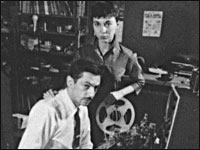 Louis & Bebe Baron: Forbidden Planet_Robby Arranges Flowers & Zaps Monkey.
Louis & Bebe Baron: Forbidden Planet_Robby Arranges Flowers & Zaps Monkey.
 Louis & Bebe Baron: Forbidden Planet_Love at the Swimming Hole
Louis & Bebe Baron: Forbidden Planet_Love at the Swimming Hole
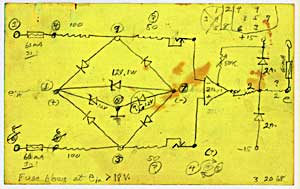 Louis & Bebe Baron: Forbidden Planet–Home Coming
Louis & Bebe Baron: Forbidden Planet–Home Coming
We began to explore the possibilities of simple circuits [that] had characteristic behavior patterns. The desiderata
was that the behavior should not be regulated, but rather non-logical. The most interesting sounds often came from circuits that were not stable….We created individual cybernetic circuits for particular themes and leit motifs… — L.B/B.B.
As a result of this process and their earlier work with the tape manipulation techiniques of musique concrète (they were actually associated with John Cage in the early days of the Project for Music for Magnetic Tape in NYC) the music often consists of short ideas spliced together.
Raymond Scott: Cindy Electronium [1959]
Created using two of Raymond’s analog synthesizers — the Clavivox, which included a keyboard (fyi: Bob Moog was his apprentice on this instrument), and the Electronium, which did not. It was this latter instrument that captured Berry Gordy’s attention and led to his being hired as director of electronic research and development at Motown.
Milton Babbitt: Ensembles for Synthesizers [1964] (excerpt) ………….. pp. 123-7
Composed using the RCA Mark II Synthesizer. Highly complex, extremely detailed music derived from 12-tone serial processes.
Makes use of the detail and precision required by the Mark II. Listen in the beginning of the piece to the dense clusters or chords that punctuate the music; each pitch has its own discrete envelope generator, so cluster “evaporates” one note at a time until there is a single pitch left “hanging.” This gesture happens repeatedly throughout the opening of the piece. It would very difficult to duplicate, requiring extensive multi-track mixing, using any of the monophonic synthesizers available at the time — and for many years to come!
https://youtu.be/W5n1pZn4izI
Wendy (Walter) Carlos: Switched on Bach [1967]
The music of J. S. Bach arranged and played on a Moog 900 series synthesizer (like OU’s old Moog). This was a very commercially successful recording (Billboard sales info: Top 10, Top 40 for 17 weeks, Top 200 for more than a year, went”platinum,” won 3 Grammy awards in 1970) which brought wide recognition to the work Moog was doing in the field of v-c analog synthesizer design. The design differences between Buchla and Moog go hand-in-hand with the differences in the style of music represented on this listening list. The lack of an organ-like keyboard on the early Buchla models results in more abstract music that was less dependent on pitch than conventional music. Switched On Bach would be unthinkable on the original Buchla synthesizers, but the Moog, which had a monophonic organ-like keyboard, was a natural for this type of project. But since the keyboard was indeed monophonic (low-key priority), multiple keyboards and/or a multi-track tape recorder were required to realize the polyphonic textures of J. S. Bach. Carlos indicated in an interview that there was often a sly attempt at humor by highlighting (through tongue-in-cheek exaggeration) some of the common misguided approaches to which performers on conventional keyboards are prone (e.g., the cartoonishly fast tempo on the Two-part Invention in F).
Wendy (Walter) Carlos: Switched on Bach — Two-part Invention in F
NOTE: Compare the envelope shapes used in the following two selections
Carlos: Switched on Bach — Two-part Invention in d
… and …
Carlos: Switched on Bach — Jesu, Joy of Man’s Desire
Carlos: Switched on Bach — Brandenburg Concerto No. 3 in G — mvt. 2 (improvised*) & mvt. 3
Note: J. S. Bach had nothing to do with the improvised movement 2. His original score merely contains two chords for the keyboard player to improvise on between the two outer movements. Carlos’s improvisation is testament to the power and flexibility of Moog’s synthesizer. Not only could it handle “traditional” music well, but it could also create unique “synthetic” sonic events not duplicatable on traditional instruments.
Morton Subotnick: Wild Bull (part A [1968]…………………………….. pp. 130-1

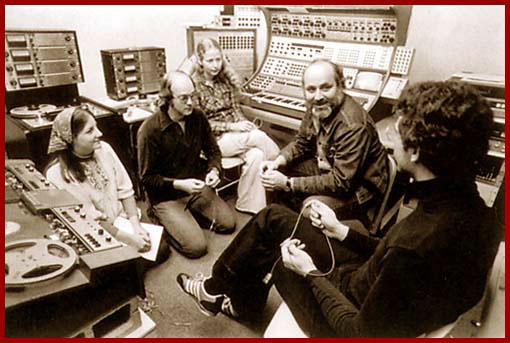 Created using a Buchla synthesizer, a large modular, voltage-controlled synthesizer. The slow, amorphous opening of the work uses timbre for coherence – establishing a whole “family” of complex, yet related “Wild Bull” sounds. Later in the piece an important characteristic of Subotnick’s music emerges; driving dance-like rhythms punctuated by unpredictable random bursts of activity. The driving rhythms are powered by an analog sequencer. This is a primitive storage device capable of storing a handful of set voltages. It has an adjustable clock-rate that determines the speed at which these stored voltages are triggered. Typical of the flexibility built into these large modular systems, these voltages could be used to control the pitch, timbre, amplitude (or any combination of these) of a carrier signal or a control signal. It could also be combined with any additional control voltages desired, which could lend tremendous variety to what might otherwise be a rather limited pattern produced by the limited storage capacity of these old sequencers. The example below is the entire piece. You are only responsible for Part I (0-13′).
Created using a Buchla synthesizer, a large modular, voltage-controlled synthesizer. The slow, amorphous opening of the work uses timbre for coherence – establishing a whole “family” of complex, yet related “Wild Bull” sounds. Later in the piece an important characteristic of Subotnick’s music emerges; driving dance-like rhythms punctuated by unpredictable random bursts of activity. The driving rhythms are powered by an analog sequencer. This is a primitive storage device capable of storing a handful of set voltages. It has an adjustable clock-rate that determines the speed at which these stored voltages are triggered. Typical of the flexibility built into these large modular systems, these voltages could be used to control the pitch, timbre, amplitude (or any combination of these) of a carrier signal or a control signal. It could also be combined with any additional control voltages desired, which could lend tremendous variety to what might otherwise be a rather limited pattern produced by the limited storage capacity of these old sequencers. The example below is the entire piece. You are only responsible for Part I (0-13′).
https://youtu.be/QIq6rLgodG4
Todd Rundgren: Dog Fight Giggle [1973]
 Large modular analog synthesizer [Arp 2500 or 2600?] used to imitate musique concrète
Large modular analog synthesizer [Arp 2500 or 2600?] used to imitate musique concrète
Stevie Wonder: from side 2 of Innervisions [1973]
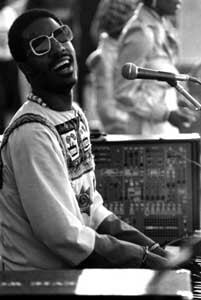 Uses Arp & Moog analog synthesizer keyboards. Stevie plays all instruments, but credits Robert Margouleff and Malcolm Cecil for programming synthesizers. Listen for extensive use of E.G. control of low-pass filter and for TM (LFO control of filter cut-off) in these songs.
Uses Arp & Moog analog synthesizer keyboards. Stevie plays all instruments, but credits Robert Margouleff and Malcolm Cecil for programming synthesizers. Listen for extensive use of E.G. control of low-pass filter and for TM (LFO control of filter cut-off) in these songs.
Stevie Wonder: Innervisions — Higher Ground
Stevie Wonder: Innervisions — Jesus Children of America
Laurie Spiegel: Appalachian Grove [1974]
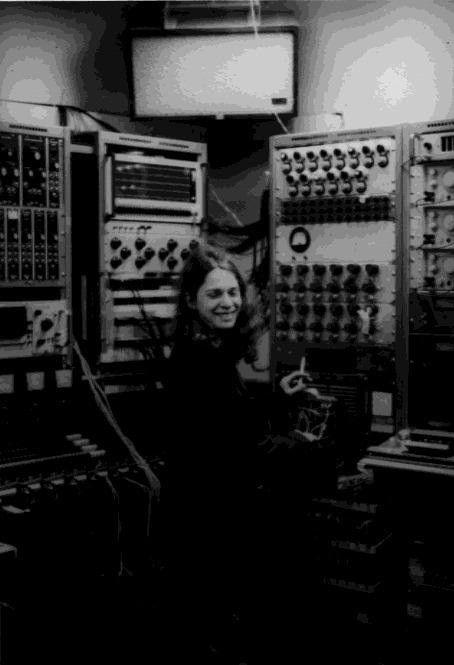 Spiegel was an early pioneer in computer music working at Bell Labs with Max Matthews, especially with the GROOVEsystem (Generated Realtime Operations On Voltage-Controlled Equipment), which is a hybrid of digital (or computer) control of analog audio equipment. All manual actions (pressing a key, tweaking a knob, etc.) were stored on a computer memory disk and could be selectively output to control the modular analog synthesizer through one of 14 independent control lines. This composition was composed after a visit to the Fiddlers’ Grove Festival in NC … and “in reaction to an overdose of heavy, sad, and introspective contemporary music.” — L.S.
Spiegel was an early pioneer in computer music working at Bell Labs with Max Matthews, especially with the GROOVEsystem (Generated Realtime Operations On Voltage-Controlled Equipment), which is a hybrid of digital (or computer) control of analog audio equipment. All manual actions (pressing a key, tweaking a knob, etc.) were stored on a computer memory disk and could be selectively output to control the modular analog synthesizer through one of 14 independent control lines. This composition was composed after a visit to the Fiddlers’ Grove Festival in NC … and “in reaction to an overdose of heavy, sad, and introspective contemporary music.” — L.S.
Mark Phillips: Lunar Illusions — finale [1981]

 Uses a large Emu 2000 series modular analog synthesizer. Features extensive use of a new generation hybrid digital/analog sequencer. A sequence was created by repeatedly playing random 3-note “chord” groupings using only the first five notes of a major scale — but only the first two notes of each “chord” are allowed to trigger a sound. (Even trying hard, which I didn’t, it is virtually impossible to play three notes at the exact same time. Though our ears may be fooled, a sensitive machine can detect the differences.) The resultant two-part sequence is stored in memory, then recorded to tape several times using different timbres, different playback speeds, and different transpositions to create a multi-layered backdrop against which two new melodic sequences were composed — a bass line and a treble line, each derived from the pitch material of the original sequence. With sequencers handling all the notes during playback, both hands are free to manipulate the dials controlling filter cut-off, filter resonance, vibrato and tremolo speed, etc. A final element is the very low-frequency (LFO) amplitude modulation (AM) which causes a low-pitched drone (root & fifth) to periodically fade in and out.
Uses a large Emu 2000 series modular analog synthesizer. Features extensive use of a new generation hybrid digital/analog sequencer. A sequence was created by repeatedly playing random 3-note “chord” groupings using only the first five notes of a major scale — but only the first two notes of each “chord” are allowed to trigger a sound. (Even trying hard, which I didn’t, it is virtually impossible to play three notes at the exact same time. Though our ears may be fooled, a sensitive machine can detect the differences.) The resultant two-part sequence is stored in memory, then recorded to tape several times using different timbres, different playback speeds, and different transpositions to create a multi-layered backdrop against which two new melodic sequences were composed — a bass line and a treble line, each derived from the pitch material of the original sequence. With sequencers handling all the notes during playback, both hands are free to manipulate the dials controlling filter cut-off, filter resonance, vibrato and tremolo speed, etc. A final element is the very low-frequency (LFO) amplitude modulation (AM) which causes a low-pitched drone (root & fifth) to periodically fade in and out.
